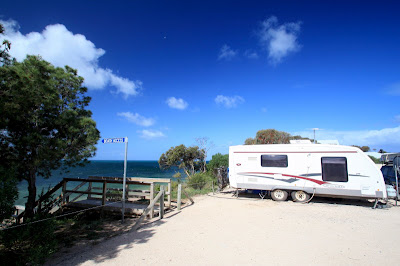 |
| Pildappa Rock Camp site at dawn |
It’s a long way from Point Lowly on the eastern side of Eyre
Peninsula to Venus Bay on the western side of Eyre Peninsula so we decided to
stay a couple of nights at Pildappa Rock free camp.
 |
| Southern face of the rock |
The rock is reached via 15 km of dirt road going
north from Minnipa which is a small wheat town on Highway No.1 half way between
Port Augusta and Ceduna. We were going to stay two nights before heading to
Venus Bay but the weather forecast of 65 km winds at Venus Bay made us decide
to extend our stay by one night. We were
hoping to get some shelter from the winds from the rock but still copped a bit
of a battering. Pildappa Rock is similar in many ways to the better known wave
rock at Hyden in WA and has extensive “wave” like rock fronts.
 |
| Camping under the southern cross |
It is quite
amazing up on top of the rock with many indentations called gammets which hold
water after rain. Some of these are quiet large and still had water in them
when we visited. There are also remnants of a small dam wall on a couple of
gammets which early settlers used to hold water longer.
 |
| Flowers at the top |
I was surprised to see wildflowers growing
on top of the rock – tough little buggers!
We made the best of being stuck at
Pildappa in the wind for a few nights by taking some time to explore some of
the local attractions.
 |
| Wind sculpture - Tcharkuldu Hill |
Nearby Tcharkuldu Hill near Minnipa was quiet
interesting with a rock wall built around the bottom of the hill which acted as
a water collection system as water flowed off the hill (smooth rocks). Must
have been quiet efficient as this was originally the sole water supply for
Minnipa. We also saw this system of water collection near Dalwallingu WA when
we visited a couple of years ago.
 |
| Organ Pipes - Gawler Ranges |
The entrance to the Gawler Ranges is 40 km by
dirt road to the north of Pildappa Rock and we decided to venture out for a day
with some guys we had met at the rock who travelling in motorhomes (had a young
pommy guy they had picked up who was on a 3 month visa and was riding his push
bike from Perth to Sydney – apparently got as far as the SA border before the roaring
NE winds started pushing him backwards and he accepted a lift). As some of the
roads were marked 4WD recommended we were there standby tow vehicle if they got
stuck. Turned out that although the 4WD roads were badly rutted in places they
were Ok for 2WD motorhomes and we didn’t have to pull anyone out J.Whilst in the Gawler
Ranges we visited the Organ Pipes, the Rock Dam and the Old Paney Homestead.
Our motorhome friends were good company and we had a great day out. Have made a
mental note to explore the Gawler Ranges further next time we are back in SA
(when the bloody wind stops blowing!).




































